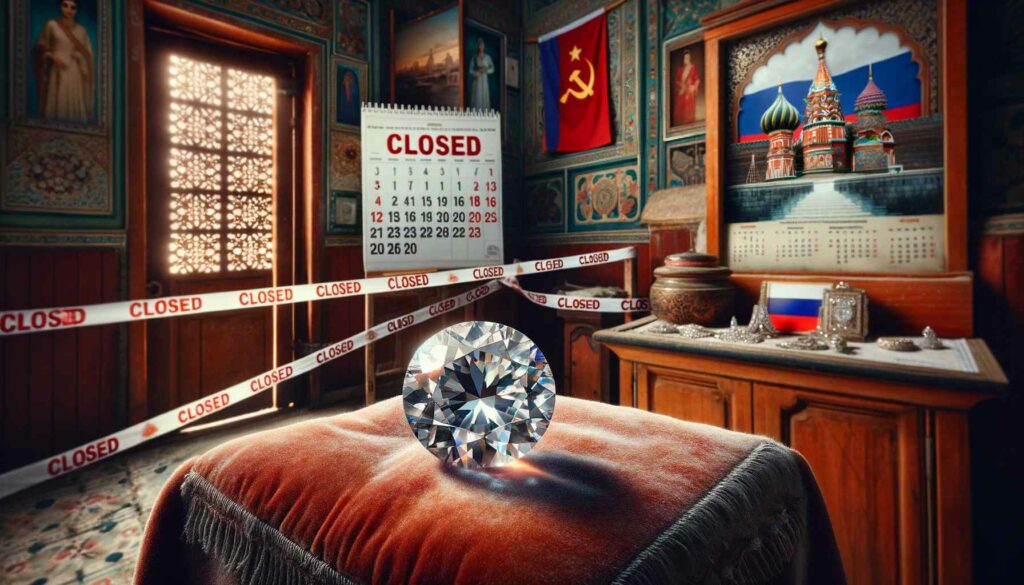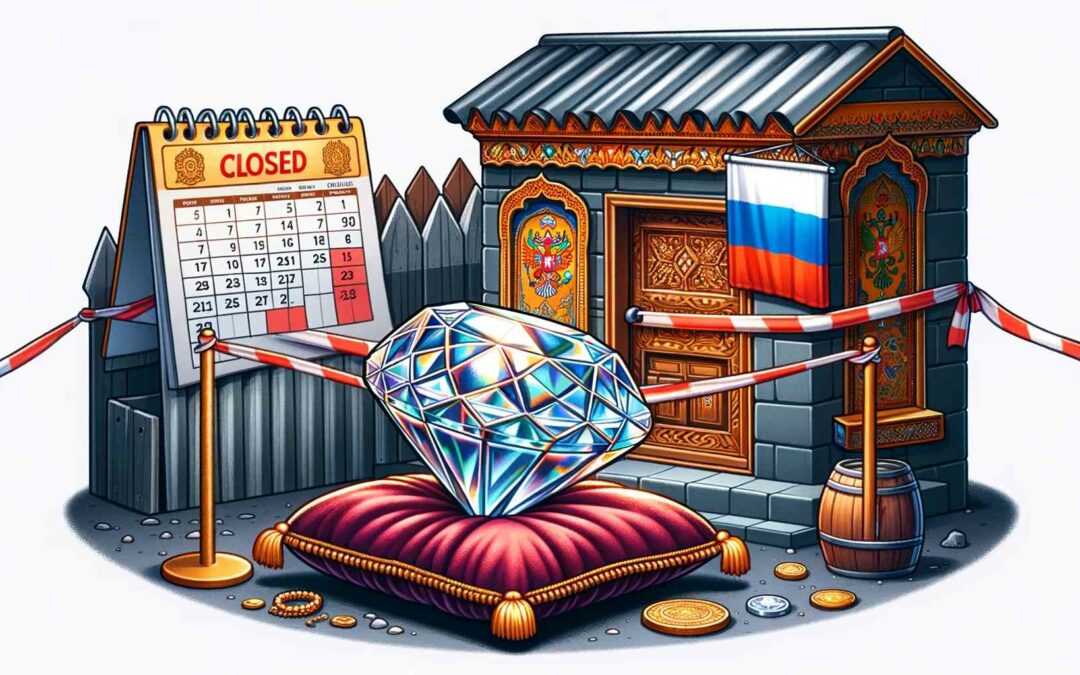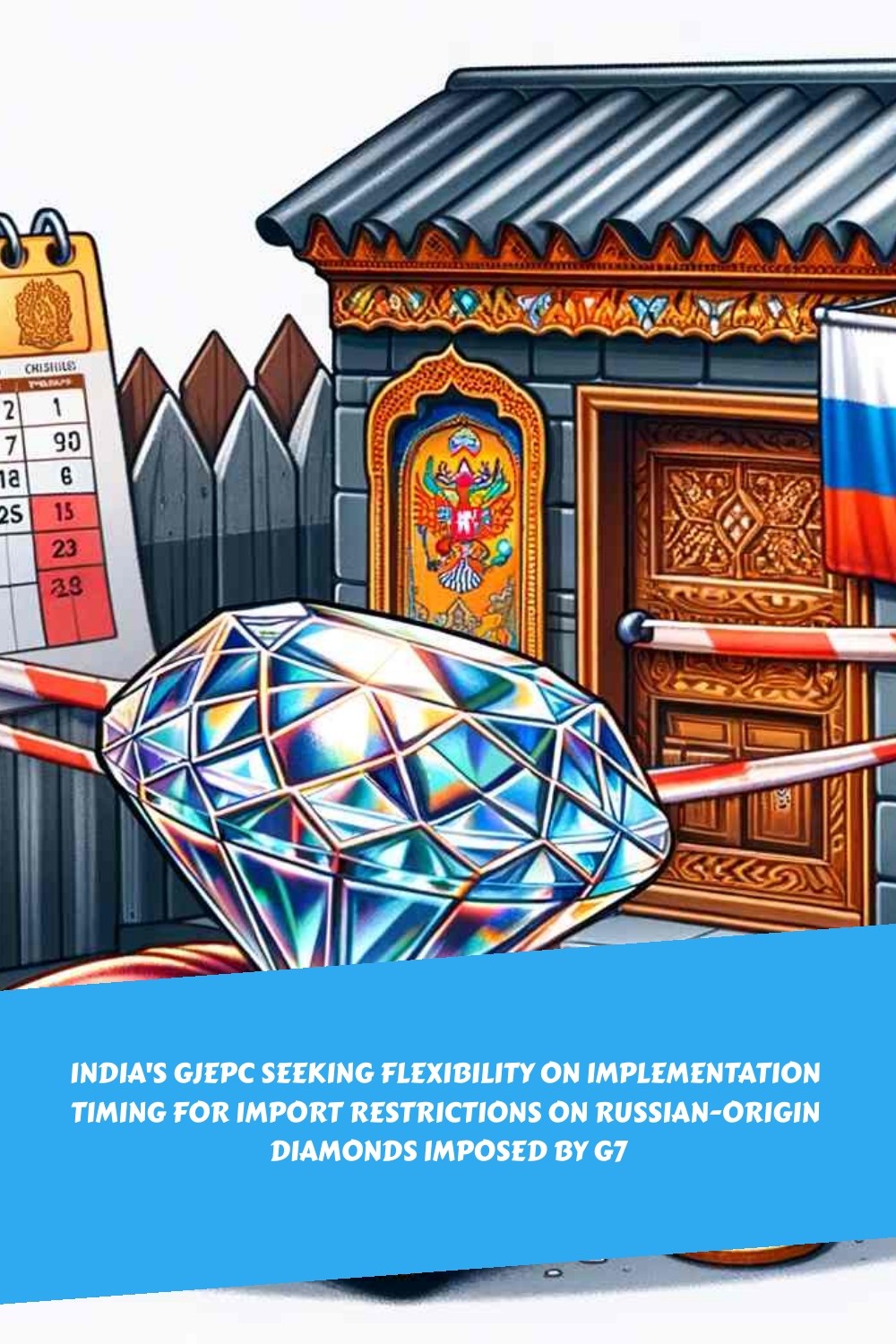Article Contents
- 1 Key Takeaways About Import Restrictions on Russian-Origin Diamonds
- 2 GJEPC’s Appeal for Leniency
- 3 Impact on the Indian Diamond Industry
- 4 G7 Sanctions Explained
- 5 Global Supply Chain Concerns
- 6 Negotiations With Major Consumers
- 7 Our Opinion on The Issue
- 8 Frequently Asked Questions About Import Restrictions on Russian-Origin Diamonds
- 8.1 How Do the G7 Import Restrictions on Russian Diamonds Affect the Global Pricing of Diamonds in the International Market?
- 8.2 What Alternative Sources of Rough Diamonds Is India Exploring to Mitigate the Impact of the G7 Restrictions?
- 8.3 How Is the GJEPC Planning to Support Small and Medium-Sized Diamond Businesses in India That Might Be Disproportionately Affected by the Import Restrictions?
- 8.4 Are There Any Technological Advancements or Innovations in Diamond Processing That Could Help India Maintain Its Competitive Edge in the Industry Despite the Restrictions?
- 8.5 How Might the G7 Import Restrictions Influence the Ethical Sourcing and Certification Processes of Diamonds Worldwide?
- 9 Resources Used To Research This Article
In the wake of the G7’s decision to impose import restrictions on Russian-origin diamonds, India’s Gem and Jewellery Export Promotion Council (GJEPC) has called for a measured execution of these measures.
As the steward of India’s esteemed diamond industry, the GJEPC is advocating for flexibility in the timing of implementation to ensure minimal disruption to the delicate equilibrium of the global diamond supply chain.
This diplomatic maneuver by the GJEPC aims to safeguard the livelihoods of countless artisans and maintain the seamless continuity of trade, which is deeply intertwined with India’s economic and cultural identity.
As discussions progress, the GJEPC remains committed to upholding the interests of its community, ensuring that every member’s voice is heard in this period of transition.
Key Takeaways About Import Restrictions on Russian-Origin Diamonds
- GJEPC has formally requested leniency from the G7 regarding the implementation schedule of import restrictions on Russian-origin diamonds.
- The Indian diamond industry is deeply intertwined with Russian diamond imports, and the G7 restrictions threaten to disrupt the supply chain and lead to a scarcity of raw materials.
- GJEPC seeks flexibility in timing to adjust to the new regulations and cushion the industry, particularly small and marginal units, from sudden shocks.
- GJEPC is engaging in dialogue with leading diamond consumers, such as the United States and China, to mitigate potential adverse effects and highlight the importance of Russian diamonds in maintaining a balanced global supply and demand scenario.
GJEPC’s Appeal for Leniency
The Gem and Jewellery Export Promotion Council (GJEPC) of India has formally requested leniency from the G7 with regard to the implementation schedule of import restrictions on Russian-origin diamonds. This appeal underscores GJEPC’s strategic approach to safeguarding the intricate balance of the Indian diamond industry.
With a vast number of small and medium-sized enterprises (SMEs) and marginal units at stake, the council has underscored the need for flexibility in adopting the proposed timelines, emphasizing the potential upheaval that abrupt enforcement could precipitate.
By seeking an eased transition, the GJEPC is attempting to mitigate the ramifications these restrictions might have on the supply chain that fulfills a significant portion of the global diamond demand. Their advocacy for deferring implementation reflects an acute awareness of the sector’s dynamics and a concerted effort to protect the livelihood of those within it.
The council’s stance is not only a call for leniency but also a demonstration of its commitment to ensuring continuity and stability for its members, thereby fostering a sense of belonging and solidarity within the industry.
In navigating this complex situation, the GJEPC’s dialogue with the G7 is indicative of its resolve to uphold the interests of the Indian diamond trade amidst international regulatory pressures.
Impact on the Indian Diamond Industry
India’s diamond sector, responsible for a significant share of global diamond processing, faces potential operational challenges due to the impending G7 restrictions on Russian-origin diamonds. The Indian diamond industry, which is a global hub for cutting and polishing rough diamonds, is deeply intertwined with Russian diamond imports. The move by the G7 to impose restrictions threatens to disrupt the supply chain and could lead to a scarcity of raw materials.
The GJEPC, recognizing the pivotal role of the Indian market in the diamond trade, seeks flexibility in timing to adjust to the new regulations. Such flexibility is deemed critical to cushion the industry, particularly small and marginal units, from sudden shocks. The Council’s request underscores the need to maintain a steady flow of rough diamonds to prevent market volatility and secure the livelihoods of countless artisans dependent on this sector.
The restrictions on Russian-origin diamonds present a complex scenario where the Indian diamond industry must navigate compliance while sustaining its export-oriented operations. The GJEPC’s engagement with stakeholders reflects a proactive approach to safeguarding the industry’s interests and ensuring continuity in a landscape marked by geopolitical tensions and economic uncertainties.
G7 Sanctions Explained
While the G7 nations have unified to impose sanctions on Russian-origin diamonds, these measures aim to curtail Russia’s ability to finance its military activities by targeting a vital export commodity. The import restrictions specifically focus on the following:
- Limiting the flow of Russian diamonds into global markets, thus impacting one of Russia’s significant export revenue streams.
- Mandating major rough diamond importers to ensure compliance creates a direct responsibility for countries with substantial diamond-processing industries.
- Implementing a ban that is expected to reshape the diamond supply chain, potentially leading to a search for alternative sources.
As a major rough diamond importer, India is confronted with the challenge of implementing G7 sanctions without disrupting its own economic interests. The precision in these sanctions is critical to avoid unintended consequences in the industry, and there is an underlying need for belonging and solidarity among G7 nations and the broader international community in enforcing these measures. The GJEPC’s request for flexibility is an appeal to balance the ethical imperative of sanctions with the practical needs of an industry that is deeply interwoven with the global economy.
This balance is particularly important given the subsequent section’s focus on global supply chain concerns, where the ripple effects of the sanctions will be examined closely.
Global Supply Chain Concerns
Several global supply chain disruptions loom as India’s diamond industry grapples with the potential ramifications of G7 import restrictions on Russian-origin diamonds. The stakes are high for a sector that intricately links the fate of small and marginal units to the ebb and flow of international markets. As the GJEPC seeks a more forgiving timeline, the concern is not only for the immediate but also for the ricochet effects that could reverberate through the interconnected global supply chain.
These import restrictions, aimed at diminishing the flow of Russian diamonds, inject uncertainty into a system that thrives on predictability and continuity. The G7’s stance could inadvertently cause a fissure in the supply chain, leading to a scarcity that inflates prices and disrupts the equilibrium between demand and supply. The Indian diamond industry advocates for a gradual and transparent approach to ensure that the transition does not become tumultuous.
The requirement to maintain the integrity of the global supply chain emphasizes the need for flexibility. Ensuring that the flow of diamonds remains uninterrupted is paramount, not just for India but for the worldwide network of consumers, retailers, and manufacturers who rely on this intricate ecosystem.

Negotiations With Major Consumers
The GJEPC is actively engaging in dialogue with leading diamond consumers, including those in the United States and China, to mitigate the potential adverse effects of the G7’s import restrictions on the industry’s supply chain. These strategic discussions are aimed at preserving the interconnectedness of global markets and ensuring the stability of the Indian gems and jewellery sector.
In its analytical approach, the export promotion council GJEPC is focusing on:
- The importance of Russian diamonds in maintaining a balanced global supply and demand scenario.
- The potential impact of import restrictions on small and medium-sized enterprises (SMEs) that form the backbone of the Indian industry.
- The need for precise and clear guidelines to navigate the complexities introduced by the Group of Seven countries’ sanctions.
These points are critical as the council seeks to align the interests of the Indian trade with the broader international community’s stance on Russian-origin diamonds. The GJEPC’s efforts are informed by a deep understanding of the market dynamics and a commitment to the welfare of the entire gems and jewellery ecosystem, which underscores the importance of belonging to a global trading family where mutual interests are both recognized and protected.
Our Opinion on The Issue
The GJEPC’s quest for flexibility in the face of G7 sanctions resembles a jeweler carefully calibrating the facets of a diamond to maximize its luster. Just as a single misstep can diminish the gem’s brilliance, hasty implementation of restrictions could fracture an industry that polishes 90% of the world’s diamonds.
The appeal underscores the delicate balance required to sustain the intricate lattice of the global diamond trade while adhering to international mandates.
Frequently Asked Questions About Import Restrictions on Russian-Origin Diamonds
How Do the G7 Import Restrictions on Russian Diamonds Affect the Global Pricing of Diamonds in the International Market?
The G7 import restrictions on Russian diamonds may lead to tightened supply and potential price increases in the global market. This disruption could cause buyers to seek alternative sources, potentially inflating costs due to scarcity.
The move also poses a risk of creating a bifurcated market where diamonds’ origin affects their accessibility and value, highlighting the need for careful industry adaptation to maintain equilibrium between consumer demand and available inventory.
What Alternative Sources of Rough Diamonds Is India Exploring to Mitigate the Impact of the G7 Restrictions?
To weather the storm of G7 restrictions, India is actively exploring alternative sources for rough diamonds. By casting a wider net, the country aims to secure supplies from African nations such as Botswana, South Africa, and Angola, as well as from Canada and Australia.
This strategic diversification ensures the continuity of India’s diamond industry, fostering a sense of community and resilience among stakeholders seeking to maintain the sector’s luster.
How Is the GJEPC Planning to Support Small and Medium-Sized Diamond Businesses in India That Might Be Disproportionately Affected by the Import Restrictions?
The Gem and Jewellery Export Promotion Council is strategizing to bolster small and medium-sized enterprises by facilitating access to alternative markets and providing skill-enhancement programs. Their efforts aim to ensure sustained business operations and mitigate the adverse effects arising from the recent import constraints.
Additionally, the council is advocating for regulatory reprieve and financial support frameworks to cushion these businesses during the transitional phase of market realignment.
Are There Any Technological Advancements or Innovations in Diamond Processing That Could Help India Maintain Its Competitive Edge in the Industry Despite the Restrictions?
In the quest to stay ahead, India’s diamond sector could leverage AI-driven automation and blockchain traceability to heighten efficiency and ensure ethical sourcing.
These innovations not only enhance competitiveness but also foster a sense of community among stakeholders committed to responsible practices.
As global norms tighten, such technological adoption may prove pivotal in preserving India’s stature in the diamond processing landscape, despite external trade constraints.
How Might the G7 Import Restrictions Influence the Ethical Sourcing and Certification Processes of Diamonds Worldwide?
The G7 import restrictions could significantly impact the global ethical sourcing and certification of diamonds. This is because the restrictions have the potential to decrease the supply of legally obtained stones.
As a result, the diamond industry may be prompted to enhance traceability and tighten certification processes. This would be done in order to assure consumers of the diamonds’ origins.
These measures could positively affect the industry by reinforcing trustworthiness. They would also foster a sense of belonging among stakeholders who are committed to ethical practices.
Resources Used To Research This Article
- https://www.thehindu.com/business/gjepc-seeks-more-time-to-implement-g7-sanctions-on-russian-diamonds/article67615780.ece
- https://www.reuters.com/world/india/india-trade-body-seeks-flexibility-g7s-phased-in-russian-gems-ban-2023-12-07
- https://www.devdiscourse.com/article/headlines/2738545-india-trade-body-seeks-flexibility-on-g7s-phased-in-russian-gems-ban
- https://theblunttimes.in/gjepc-raises-concerns-over-g7-restrictions-on-russian-origin-diamonds/38433
- https://sg.finance.yahoo.com/news/indian-trade-bodies-call-two-114051998.html



